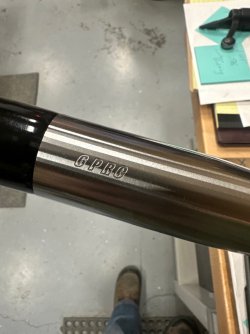My 6.5PRC 22" 8twist did ok with Magnum, not bad, same with H1000 and IMR7977, so I went faster and tried H4350 and got better speeds and accuracy. Then tried A4350 and that was the one. This was primarily with monos 122-127gr but some heavy eldms as well. This has worked out the same in my 270WSM as well. Jus somethin to keep in the bullpen.
Incidentally Ive had 3 rifles where a 127LRX and 147ELDM took same charge of the same powder as max load. I figure its that loong bearing surface on the mono.
Yeah the LRX seems to lack one or two of the grooves of the TSX/TTSX, so there is more bearing surface there, even compared to other Barnes bullets. I also attribute it to increased stiffness of the mono. I believe it creates a bit more inertia to overcome. Kind of like falling off a balcony and hitting the ground vs hitting concrete. Both are bad, but concrete is definitely worse. There's a bit of give or spring back or something. While you won't see an imprint on the ground unless it's really soft or your balcony is really high, the hardness is way less than concrete. Same idea with the lead core and thin jacket vs monolithic. Even when Barnes just made the original X without grooves. Bearing surface was same as other bullets with similar design like a flat-based Hornady or Speer, but they would take nowhere near as much powder to reach max pressure. Even a bullet that is MOSTLY monolithic with a little lead bonded in the frontal core (ala Bear Claws, and to a lesser degree, A-Frames) will max out on pressure with less powder (and speed) than other cup and cores.
Now, I shot 140gr Ballistic Tips and 120gr Ballistic Tips in my 6.5 PRC with 1:8 26" Bartlein. I had to seat deeper in the case than you with your 143 Hornady. I was very disappointed in speed with mine, and accuracy wasn't very good until I tried Magnum in a recommendation by somebody on this forum, I believe. Gave some of my best velocity and WAY better accuracy with the traditional bullet styles.
There are so many factors to consider in the dynamics of handloading, it's nearly impossible to consider them all for every application. Seating depth, neck tension, bearing surface, twist to some degree, possibly metallurgical properties of the bullets loaded (and barrel), bullet weight, case capacity, powder volume, ambient conditions, and primer heat when fired ALL affect pressure and velocity to some degree. I'm sure there are more things, these are just a few off the top of my head. Chamber dimensions is another. See, I missed one. Bore fouling - missed another... you get my point. I should probably start back over back at the 4350 rate of burn and go slower to find the new sweet spot for the bullet I finally decide to use. I appreciate you making me rethink this. Whenever I think I have it figured out is precisely when I don't!

